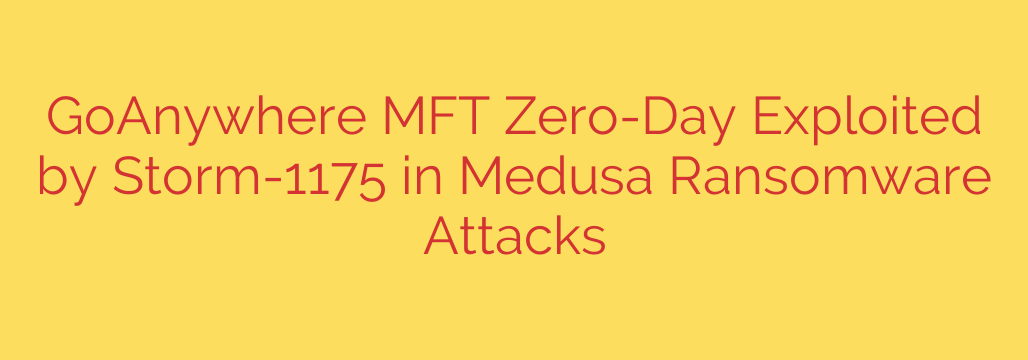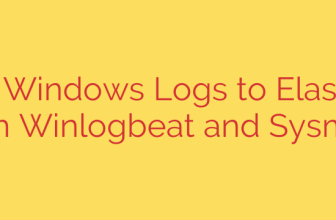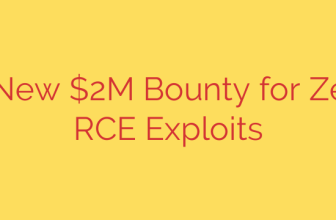
Critical GoAnywhere Vulnerability Actively Exploited to Deploy Medusa Ransomware
A severe zero-day vulnerability in Fortra’s GoAnywhere MFT (Managed File Transfer) solution is being actively exploited in the wild by a financially motivated threat actor to deploy Medusa ransomware. This critical security flaw requires immediate attention from all organizations utilizing the software to prevent significant data breaches and network-wide encryption events.
The vulnerability, tracked as CVE-2024-0204, is an authentication bypass issue within the GoAnywhere MFT administration portal. With a high severity score of 9.8 out of 10, this flaw allows an unauthenticated attacker to remotely create a new administrative user with full privileges on a vulnerable system. This provides a direct and dangerous entry point into a company’s network.
The Attack Chain: From Entry to Encryption
Cybersecurity researchers have identified the threat actor Storm-1175 as the primary group weaponizing this exploit. Their attack methodology is swift and effective, following a clear and concerning pattern:
Initial Access: The attackers first scan the internet for unpatched GoAnywhere MFT instances. Upon finding a vulnerable server, they exploit CVE-2024-0204 to create a malicious administrative account.
Post-Exploitation Activity: Once inside, the threat actor leverages their newfound administrative access to perform reconnaissance. They have been observed downloading malicious tools, most notably deploying a payload for the remote access tool Cobalt Strike. This gives them persistent control over the compromised server.
Lateral Movement and Data Exfiltration: Using the compromised GoAnywhere server as a beachhead, Storm-1175 moves laterally across the victim’s network, escalating privileges and identifying valuable data. A key part of their strategy involves exfiltrating sensitive files before triggering the final encryption phase.
Ransomware Deployment: In the final stage, the attackers deploy the Medusa ransomware payload across the network. This encrypts critical files and servers, rendering them inaccessible. The attackers then demand a ransom payment in exchange for the decryption key and a promise not to leak the stolen data—a tactic known as double extortion.
Who is Storm-1175?
Storm-1175 is a known cybercrime group focused on financial gain through ransomware operations. They have a history of exploiting known vulnerabilities in public-facing applications to gain initial access to corporate networks. Their choice to rapidly adopt and exploit the GoAnywhere zero-day demonstrates their sophistication and ability to operationalize new vulnerabilities quickly.
Urgent Security Recommendations to Protect Your Organization
Given the active exploitation of this vulnerability, immediate action is paramount. If your organization uses GoAnywhere MFT, follow these critical steps to mitigate the risk.
Patch Immediately: The most critical step is to update your GoAnywhere MFT instance to version 7.4.1 or later. Fortra has released a patch that fully remediates CVE-2024-0204. Prioritize this update above all other measures.
Implement Workarounds if Patching is Delayed: If you cannot immediately apply the patch, use the temporary workarounds provided by the vendor. This involves deleting the
InitialAccountSetup.xhtmlfile in the installation directory and restarting the services. However, this should only be considered a temporary fix until you can patch the system.Restrict Access to the Admin Portal: Ensure that the GoAnywhere MFT administration portal is not exposed to the public internet. Access should be restricted to trusted IP addresses and managed through a secure VPN. This drastically reduces the attack surface.
Hunt for Indicators of Compromise (IOCs): Proactively search your systems for signs of a breach. Look for unrecognized administrative accounts, suspicious network connections originating from the GoAnywhere server, or the presence of tools like Cobalt Strike. If any suspicious activity is found, assume a compromise and activate your incident response plan.
Review Network Segmentation: Strong network segmentation can limit an attacker’s ability to move laterally from a compromised server to other critical parts of your infrastructure. Ensure that sensitive systems are isolated from public-facing applications.
This incident is a stark reminder of how quickly threat actors can weaponize newly discovered vulnerabilities. Staying vigilant, maintaining a robust patching cadence, and employing a defense-in-depth security strategy are essential to defending against sophisticated threats like Medusa ransomware.
Source: https://securityaffairs.com/183075/hacking/goanywhere-mft-zero-day-used-by-storm-1175-in-medusa-ransomware-campaigns.html








